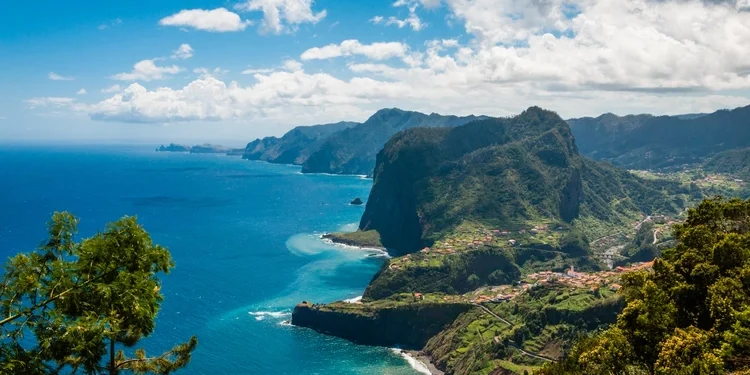Madeira is an archipelago made up of three main islands (Madeira, Porto Santo, and the Desertas) that float 1,000 kilometers southwest of mainland Europe in the North Atlantic Ocean.
A giant chunk of seafloor wrenched above the surface, Madeira has a dramatic landscape full of jagged peaks and wind-sculpted cliffs. Sweeping sea views are available from most vantage points.
Lush vegetation abounds, including wild pineapple, banana, and passionfruit.
It’s not what you expect from Europe… In fact, when I arrived, Hawaii was the first place that came to mind. Bali was the second.
Geographically, Madeira is closer to Africa (the coast of Morocco is only 520 kilometers away) than Europe but, when you get to the Old Town of Funchal and see the narrow cobblestone streets, historical buildings, and thriving café culture, you’re reminded you are indeed in the Old World.
And there’s a lot to like here…
Madeira is called the island of eternal spring because of its pleasant year-round weather, which includes warm ocean waters. As a result, its booming tourism industry is unaffected by the seasons.
Madeira’s beaches are award-winning and the island is laced by ancient irrigation lines called levadas, which today are popular hiking routes. It has
unique geographic features like capes, canyons, and caves.
Golf, surfing, big game fishing, birdwatching, kayaking, sailing, scuba diving, and whale-watching are a few of the things you can do here.
There’s also an active culture and gastronomy scene that includes seafood and its eponymous libation, Madeira wine.
It’s affordable. Rent for a two-bedroom home in Funchal, the capital, starts at about 1,000 euros per month. Utilities will run you around 80 euros per month and groceries around 300 euros per month.
A meal out for two, with drinks, costs around 50 euros. To run your own car, budget around 50 euros per month.
Get Your Free Portugal Report Today!
Simply enter your email address below and we'll send you our FREE REPORT — Portugal: The World’s #1 Retirement Haven...
It’s as safe as can be. Portugal is the seventh-safest country in the world, according to the Global Peace Index, and Madeira has lower crime rates than the mainland. My personal experience is that I’ve never felt safer traveling somewhere on my own.
For all the reasons already listed, plus good health care and education, Madeira is popular with expats from Germany, France, Austria, and the U.K., plus a
growing number of North Americans.
Among them is Alan Featherstone, a former florist from the U.K., who first discovered Madeira some 30 years ago.
“My wife and I found a cheap holiday for 50 pounds each. That’s how we ended up here,” says Alan. “We went to a welcome meeting and heard that there was no crime here… and 30 years later, this still holds true.
“Eighteen years ago, we bought an apartment in the seaside village of Madalena do Mar. During that time, we’d bounce back and forth between Madeira and Liverpool, spending a week, a month, or six months here and there.
“We decided to retire six years ago. We took some of our pension money and bought a house, which we redesigned to have multiple self-contained apartments. We rent these out, and they can provide good income. We rent to digital nomads, and we’ve got one long-term tenant. He’s happy where he is, and we’re happy with what he pays us.
“If you live where the locals live, you can live cheap. A meal for two is about 30 euros, including wine, for instance. If you live in a tourist area, you’ll pay a lot more. If you’re 30 years old, you’ll find the price of property high. It can be hard for locals, too, because they don’t earn a lot…
“I’ve got an American friend that doesn’t want anyone else coming here in case they drive up the cost of living further… but newcomers also create new jobs in construction, tourism, hospitality, etc. I believe it’s good for the island, so I keep telling people to come here!”
Sincerely,

Sophia Titley
Editor, Overseas Living Letter










